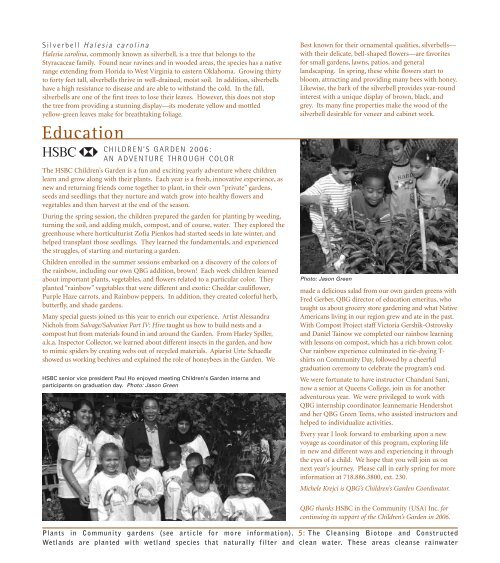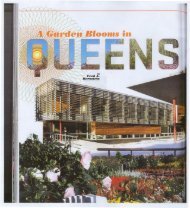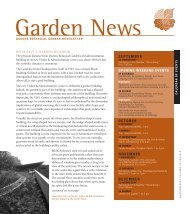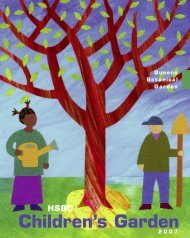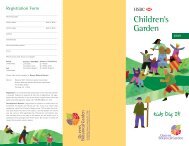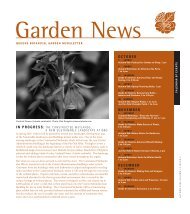Autumn Newsletter 2006 - Queens Botanical Garden
Autumn Newsletter 2006 - Queens Botanical Garden
Autumn Newsletter 2006 - Queens Botanical Garden
Create successful ePaper yourself
Turn your PDF publications into a flip-book with our unique Google optimized e-Paper software.
Silverbell Halesia carolinaHalesia carolina, commonly known as silverbell, is a tree that belongs to theStyracaceae family. Found near ravines and in wooded areas, the species has a nativerange extending from Florida to West Virginia to eastern Oklahoma. Growing thirtyto forty feet tall, silverbells thrive in well-drained, moist soil. In addition, silverbellshave a high resistance to disease and are able to withstand the cold. In the fall,silverbells are one of the first trees to lose their leaves. However, this does not stopthe tree from providing a stunning display—its moderate yellow and mottledyellow-green leaves make for breathtaking foliage.EducationCHILDREN’S GARDEN <strong>2006</strong>:AN ADVENTURE THROUGH COLORThe HSBC Children’s <strong>Garden</strong> is a fun and exciting yearly adventure where childrenlearn and grow along with their plants. Each year is a fresh, innovative experience, asnew and returning friends come together to plant, in their own “private” gardens,seeds and seedlings that they nurture and watch grow into healthy flowers andvegetables and then harvest at the end of the season.During the spring session, the children prepared the garden for planting by weeding,turning the soil, and adding mulch, compost, and of course, water. They explored thegreenhouse where horticulturist Zofia Pienkos had started seeds in late winter, andhelped transplant those seedlings. They learned the fundamentals, and experiencedthe struggles, of starting and nurturing a garden.Children enrolled in the summer sessions embarked on a discovery of the colors ofthe rainbow, including our own QBG addition, brown! Each week children learnedabout important plants, vegetables, and flowers related to a particular color. Theyplanted “rainbow” vegetables that were different and exotic: Cheddar cauliflower,Purple Haze carrots, and Rainbow peppers. In addition, they created colorful herb,butterfly, and shade gardens.Many special guests joined us this year to enrich our experience. Artist AlessandraNichols from Salvage/Salvation Part IV: Hive taught us how to build nests and acompost hut from materials found in and around the <strong>Garden</strong>. From Harley Spiller,a.k.a. Inspector Collector, we learned about different insects in the garden, and howto mimic spiders by creating webs out of recycled materials. Apiarist Urte Schaedleshowed us working beehives and explained the role of honeybees in the <strong>Garden</strong>. WeHSBC senior vice president Paul Ho enjoyed meeting Children's <strong>Garden</strong> interns andparticipants on graduation day. Photo: Jason GreenBest known for their ornamental qualities, silverbells—with their delicate, bell-shaped flowers—are favoritesfor small gardens, lawns, patios, and generallandscaping. In spring, these white flowers start tobloom, attracting and providing many bees with honey.Likewise, the bark of the silverbell provides year-roundinterest with a unique display of brown, black, andgrey. Its many fine properties make the wood of thesilverbell desirable for veneer and cabinet work.Photo: Jason Greenmade a delicious salad from our own garden greens withFred Gerber, QBG director of education emeritus, whotaught us about grocery store gardening and what NativeAmericans living in our region grew and ate in the past.With Compost Project staff Victoria Gershik-Ostrovskyand Daniel Tainow we completed our rainbow learningwith lessons on compost, which has a rich brown color.Our rainbow experience culminated in tie-dyeing T-shirts on Community Day, followed by a cheerfulgraduation ceremony to celebrate the program’s end.We were fortunate to have instructor Chandani Sani,now a senior at <strong>Queens</strong> College, join us for anotheradventurous year. We were privileged to work withQBG internship coordinator Jeannemarie Hendershotand her QBG Green Teens, who assisted instructors andhelped to individualize activities.Every year I look forward to embarking upon a newvoyage as coordinator of this program, exploring lifein new and different ways and experiencing it throughthe eyes of a child. We hope that you will join us onnext year’s journey. Please call in early spring for moreinformation at 718.886.3800, ext. 230.Michele Krejci is QBG’s Children’s <strong>Garden</strong> Coordinator.QBG thanks HSBC in the Community (USA) Inc. forcontinuing its support of the Children’s <strong>Garden</strong> in <strong>2006</strong>.Plants in Community gardens (see article for more information). 5: The Cleansing Biotope and ConstructedWetlands are planted with wetland species that naturally filter and clean water. These areas cleanse rainwater


